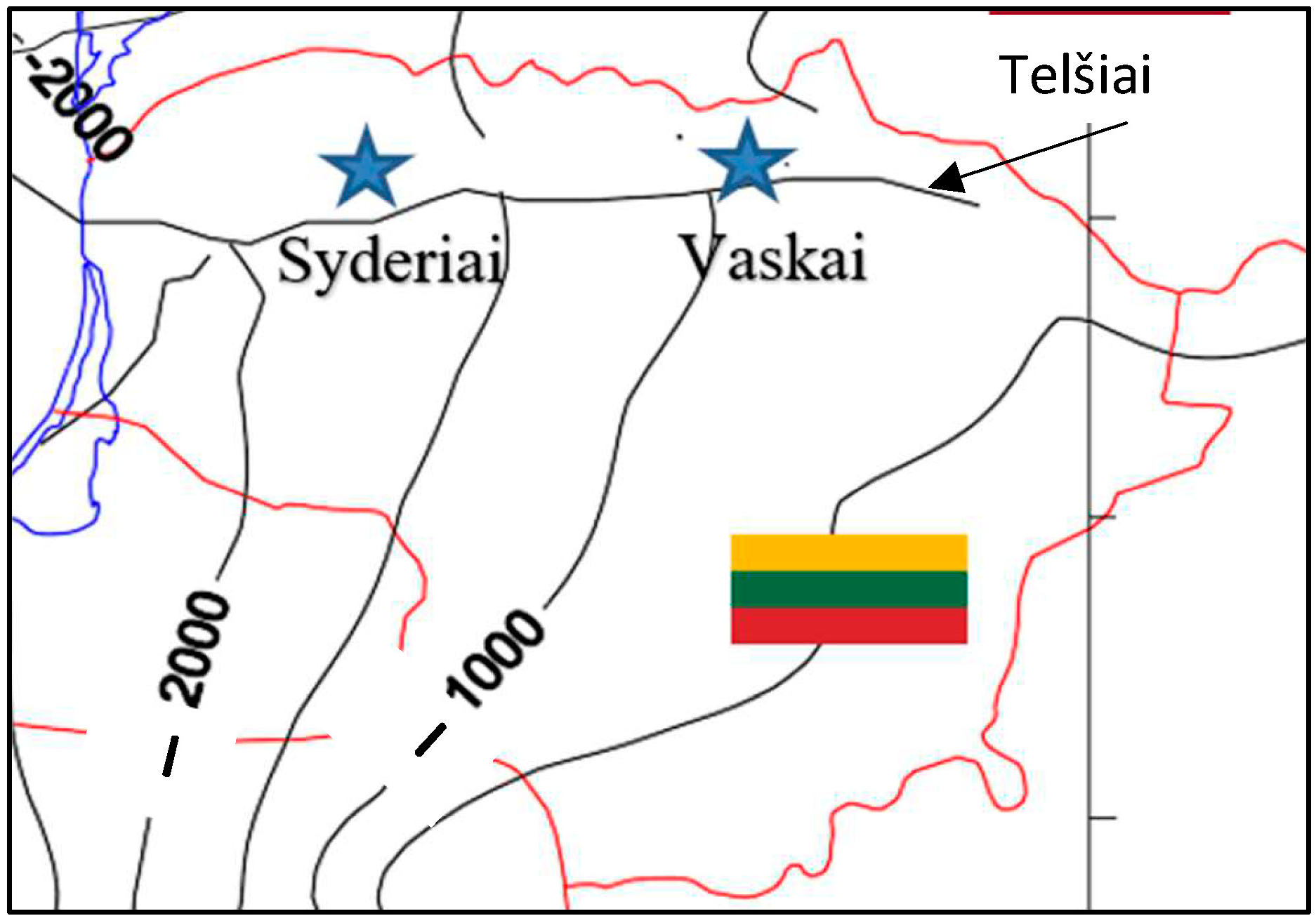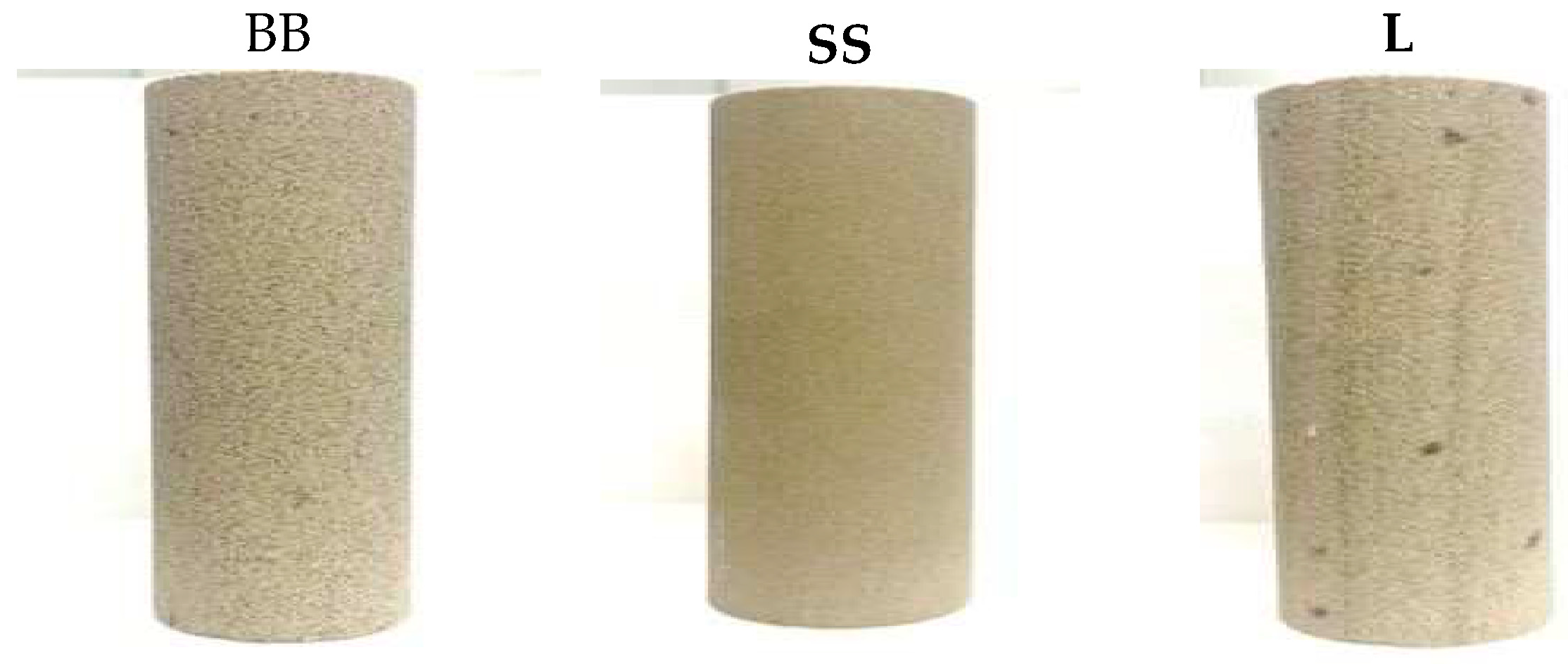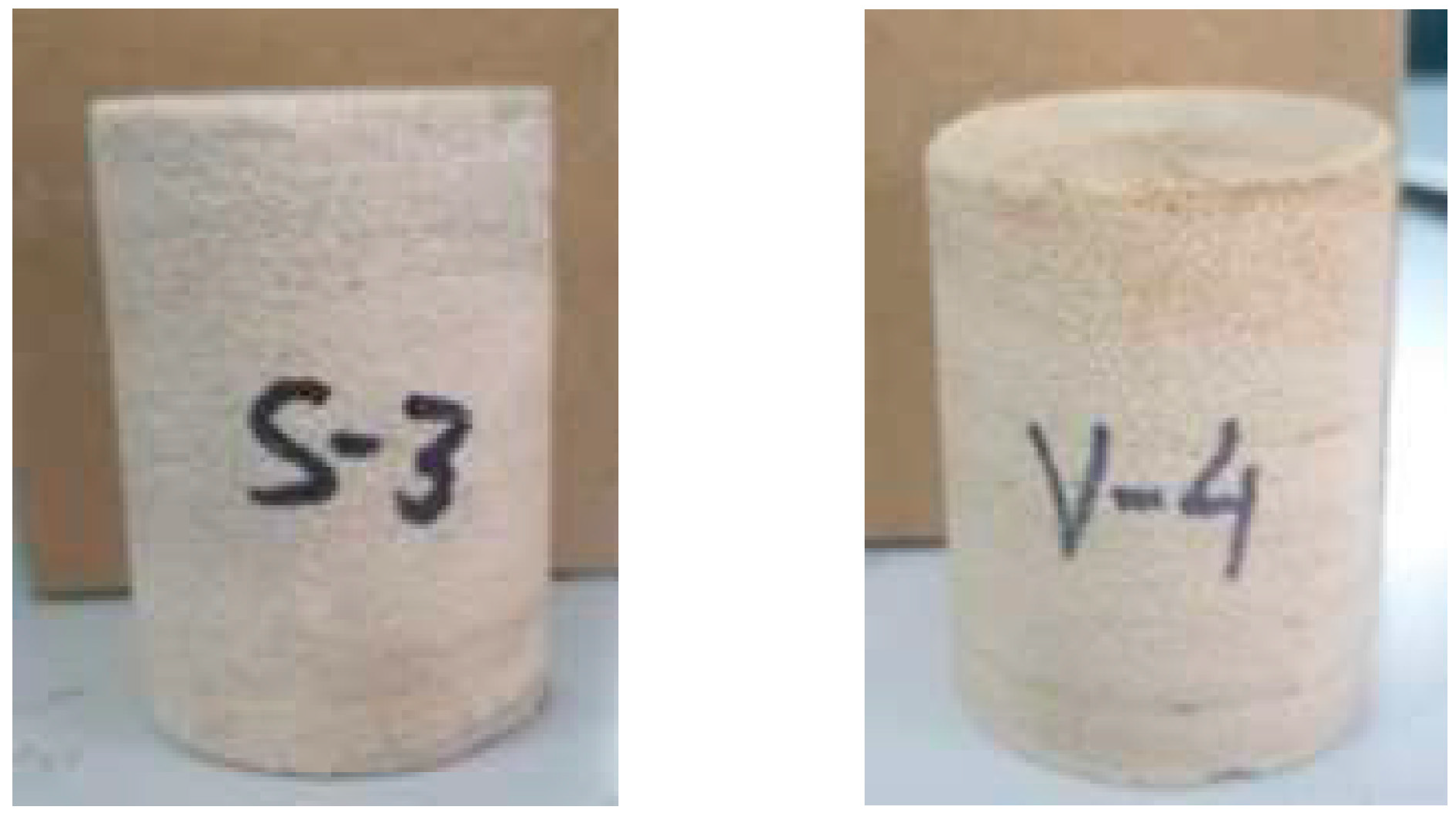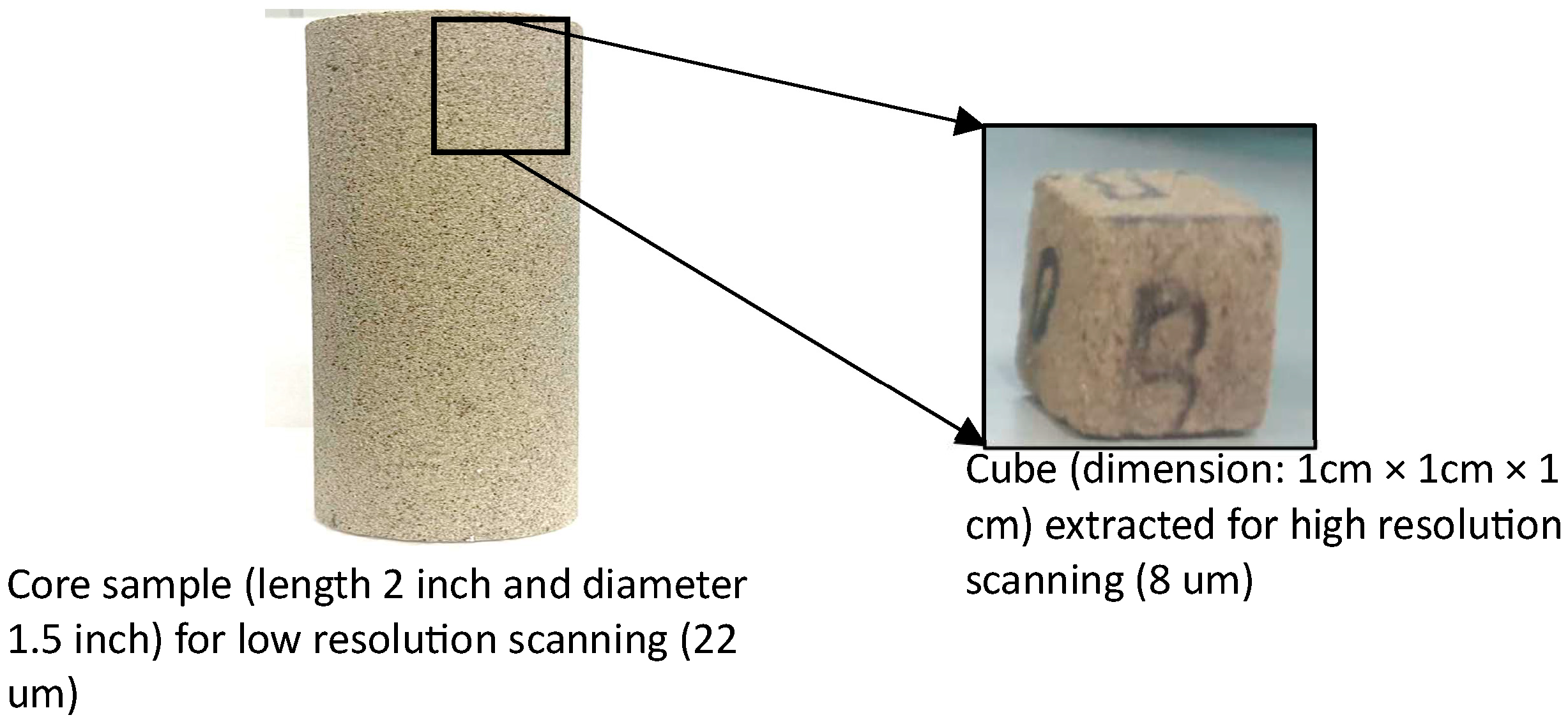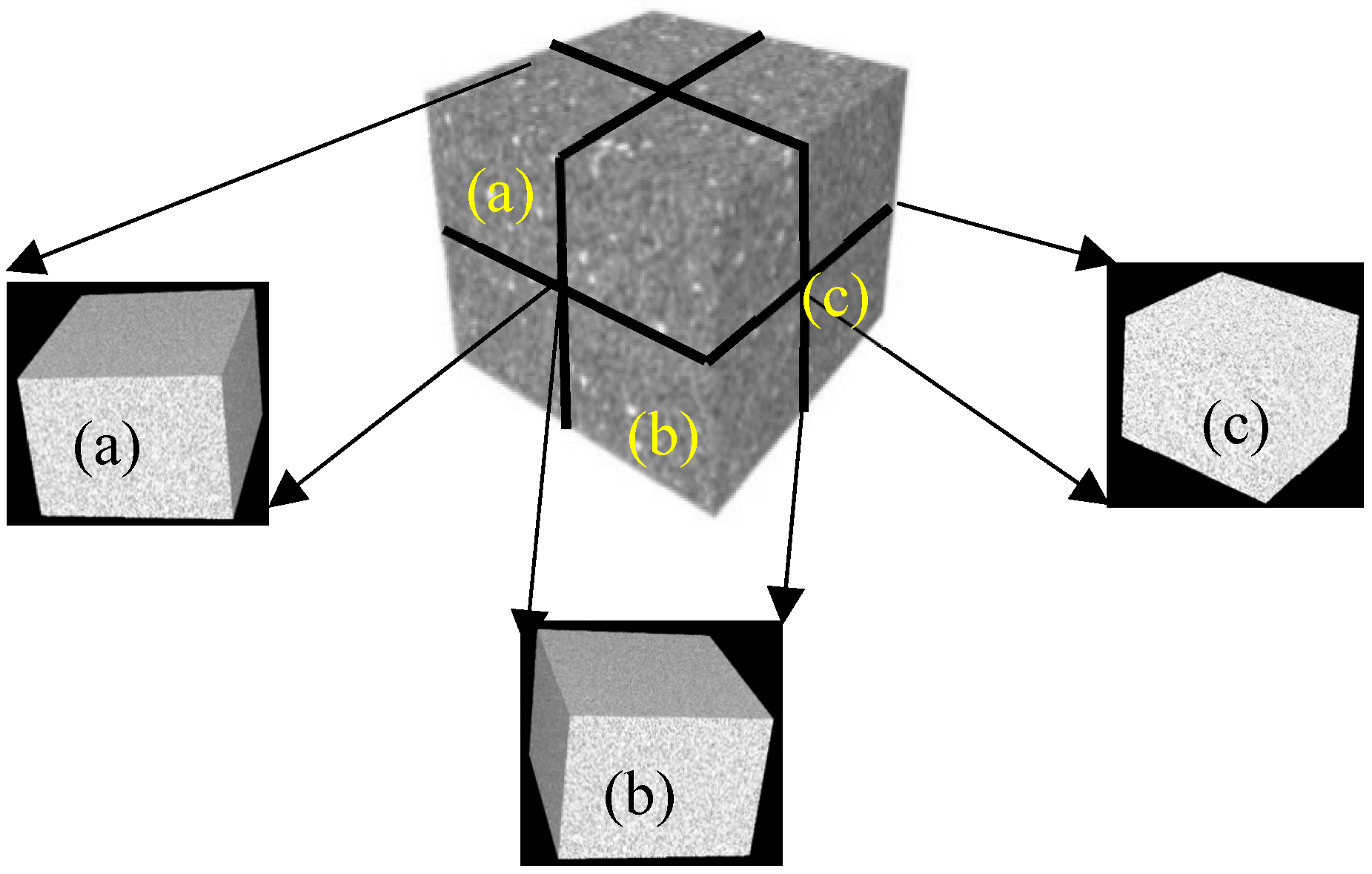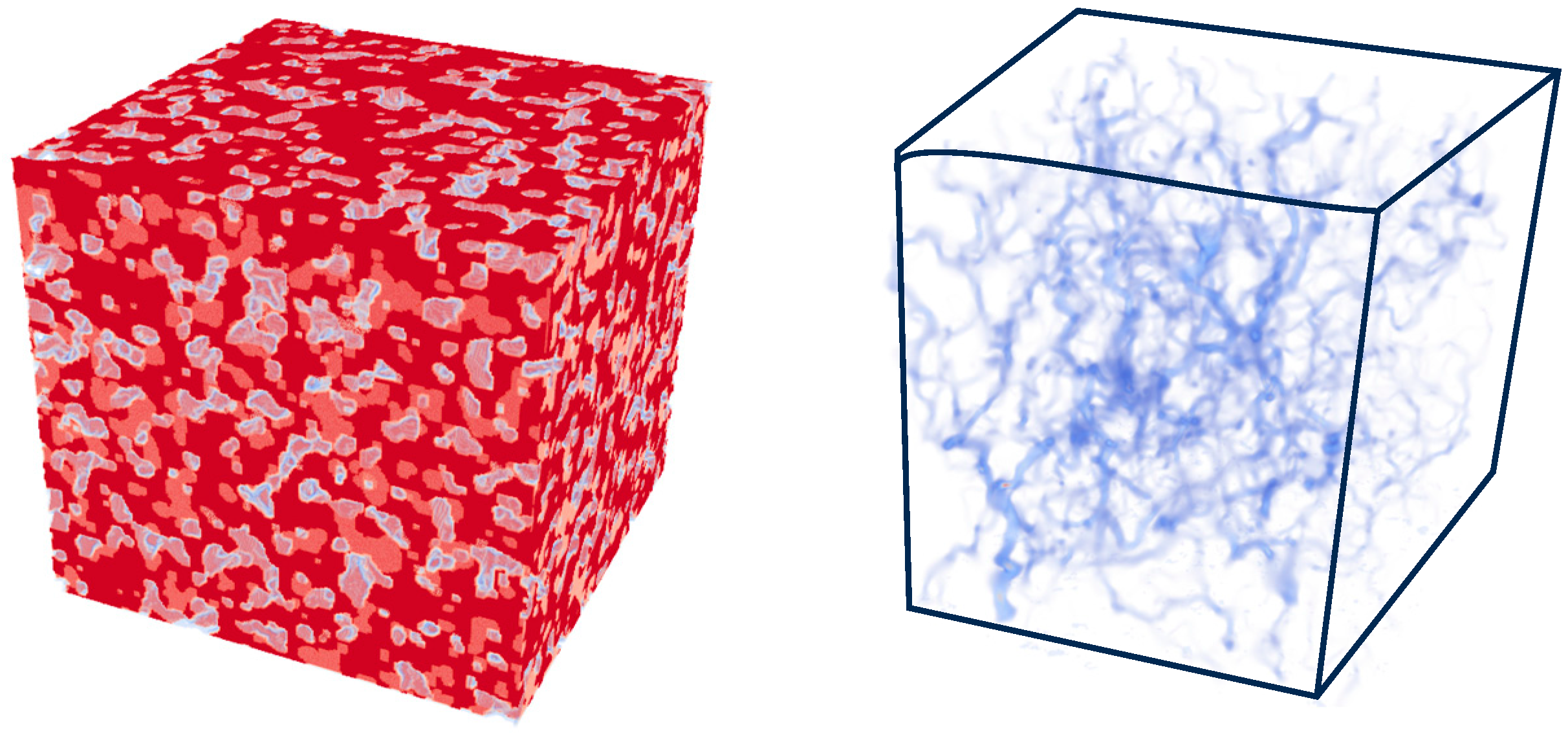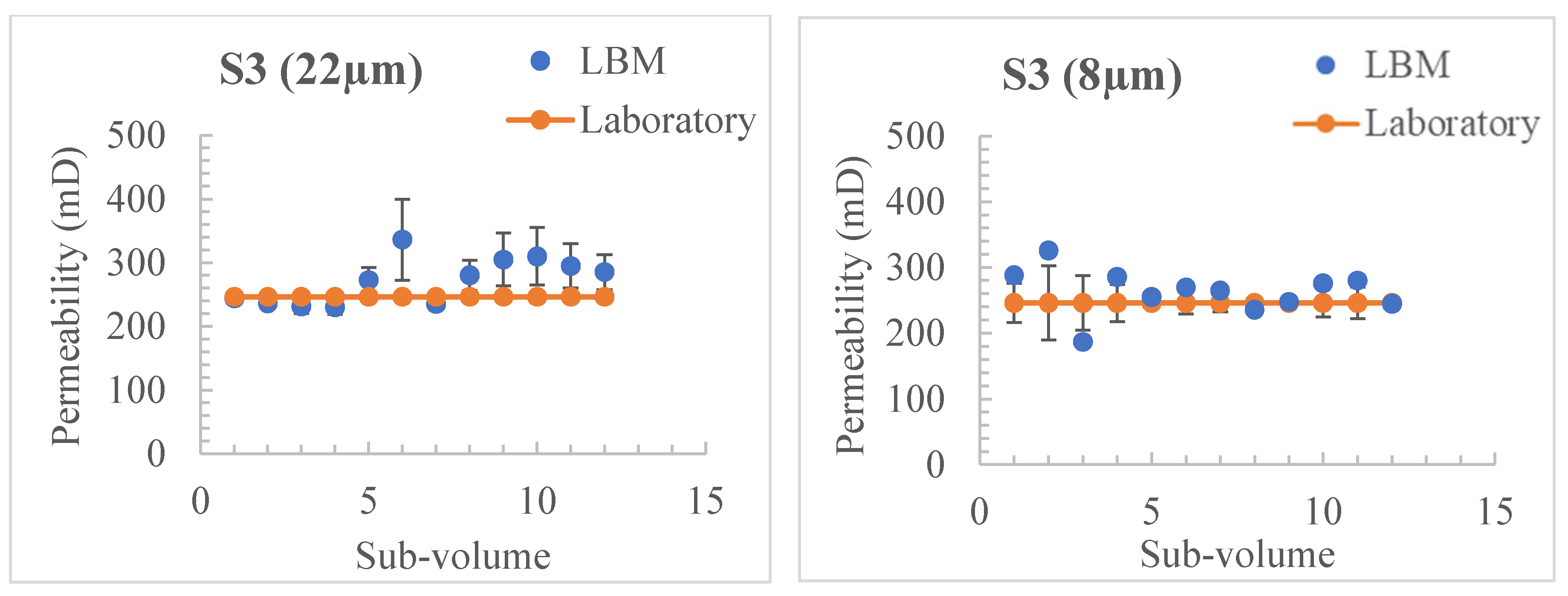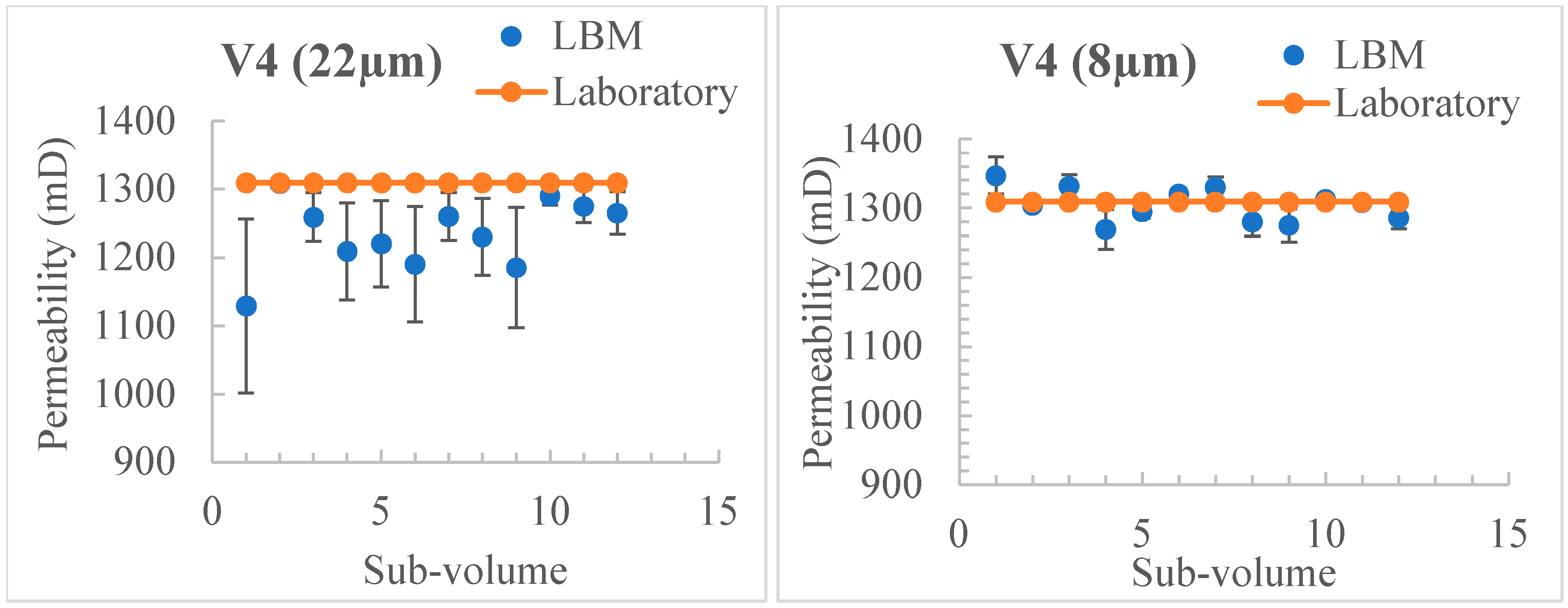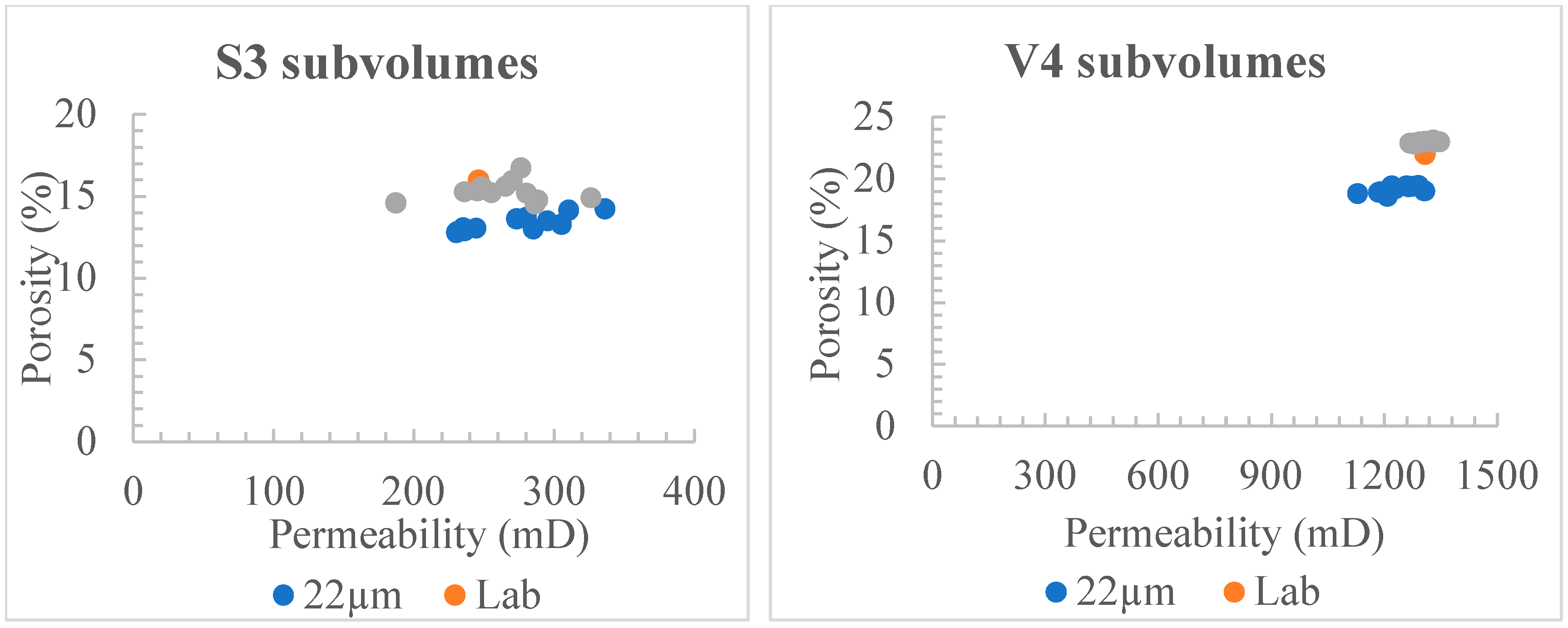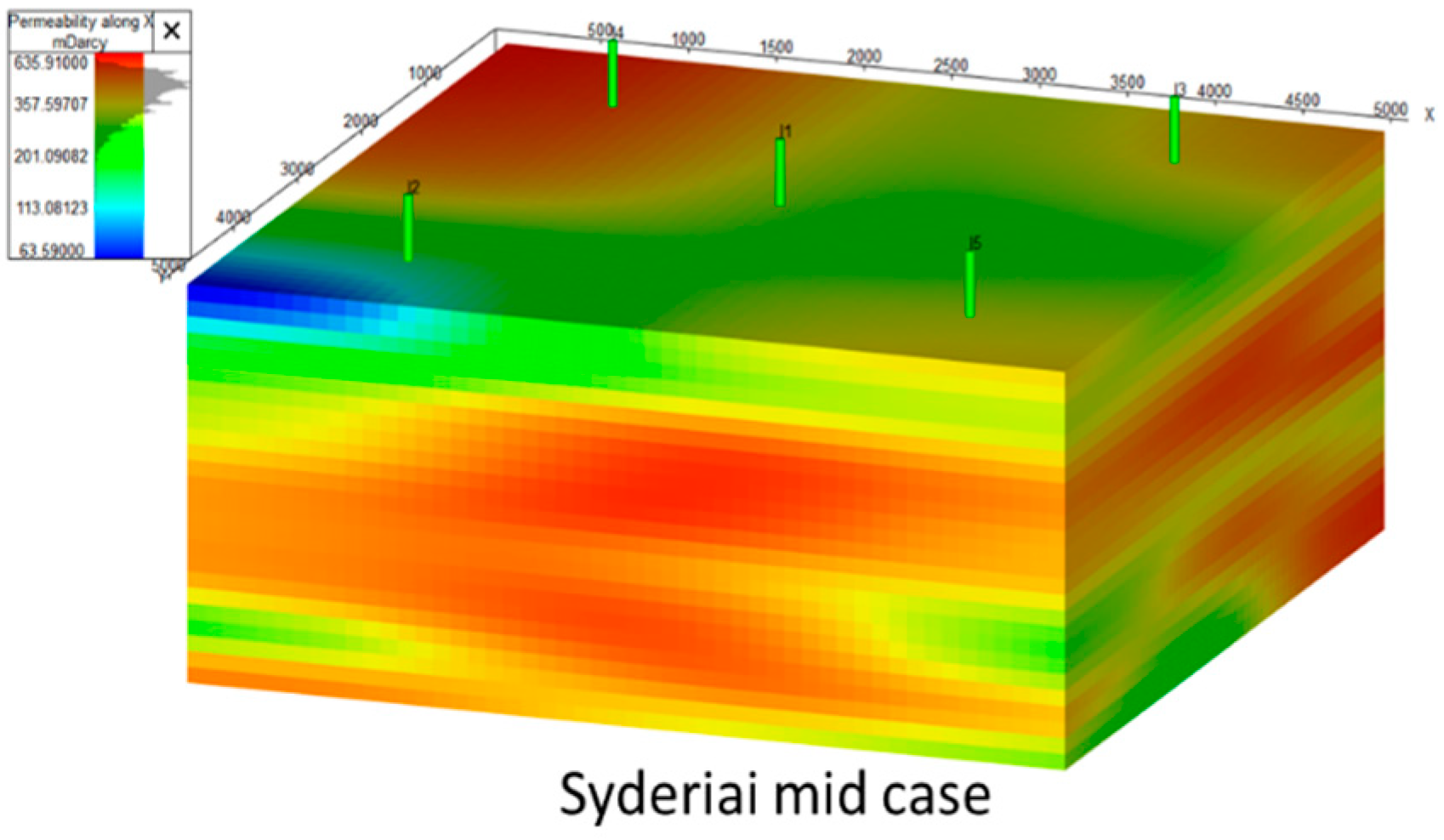1. Introduction
Among greenhouse gases, CO
2 is considered the primary contributor to global warming. According to NASA (2023) [
1], CO
2 levels remained relatively stable for the past 800,000 years, not exceeding 300 ppm until the last 60–70 years. During this recent period, CO
2 levels have increased 100 times faster, highlighting the urgent need to reduce these rising levels and mitigate the effects of climate change, thereby maintaining the goal of keeping the global temperature increase to below 1.5 °C, as discussed at the COP27 meeting in Egypt [
1].
In response to this challenge, Carbon Capture and Storage (CCS) has emerged as an effective method. CCS primarily focusses on the storage aspect, involving the containment of captured CO
2 within various geological formations. These geological formations encompass different reservoirs that serve as suitable CO
2 storage sites, such as depleted hydrocarbon reservoirs, considered the most reliable due to their well-understood conditions [
2], and deep saline aquifers are considered the most suitable due to their wide availability and proximity to CO
2 emission sources. Other potential storage-site options include salt accumulations and coal beds [
3,
4,
5,
6].
The Baltic basin, encompassing the countries of Estonia, Latvia, and Lithuania, has a thickness ranging from 100 m in Estonia to up to 1900 m in Latvia and 2300 m in Lithuania [
7]. To effectively store CO
2 in a supercritical state, specific conditions must be met, including a minimum depth of 800 m and the presence of porous and permeable reservoir rocks with impermeable caprocks. Therefore, only Latvia and Lithuania have reservoirs suitable for CO
2 sequestration, such as depleted hydrocarbon reserves and saline aquifers (
Figure 1), located at depths of more than 800 m [
7,
8,
9,
10].
The effective and secure storage of injected CO2 in subsurface reservoirs necessitates a thorough understanding of the distribution of pores and grains within these reservoirs, particularly at the microscopic scale. Porosity and permeability are the two important parameters that influence the injectivity and storage of CO2 in geological formations. High porosity provides ample space for CO2 containment, while high permeability allows for the efficient injection and distribution of CO2 into reservoirs. These factors directly impact the feasibility, efficiency, long-term stability, and security of stored CO2.
Numerous studies have sought to understand the efficiency and suitability of a reservoir for the storage of CO
2, including the utilization of reservoirs for the enhanced recovery of hydrocarbons. Various key factors that play a crucial role in the storage of CO
2 includes porosity, permeability, rock–brine–CO
2 interactions, wettability, and trapping mechanisms.
Table 1 presents recent advancements of the work conducted by various researchers around the globe for the safe and efficient storage of CO
2, including the utilization of scanned images in evaluating the efficacy of a reservoir.
The studies summarized in
Table 1 demonstrate the global efforts to understand and improve CCS techniques. Many researchers have employed MXCT imaging to assess reservoir efficiency and estimate storage potentials [
24]. While factors like wettability and secondary imbibition play significant roles in CO
2 storage, petrophysical properties—especially porosity and permeability—are the most critical determinants of a reservoir’s suitability for CCS. This study addresses a research gap in the literature by providing the results of an experimental analysis of core samples from Lithuanian deep saline aquifers, which have not previously been studied. Existing studies on CO
2 storage in Lithuanian formations have primarily focused on theoretical models, leaving a gap in understanding the specific petrophysical characteristics of the formations.
In this research, MXCT imaging was used to analyze key petrophysical parameters, such as porosity and permeability, at the pore scale [
25,
26]. The methodology was benchmarked using core samples from analogous formations that are representative of Lithuanian aquifers. This study then applied the same analysis to actual core samples from the Lithuanian reservoirs. This approach ensures robust and accurate data that can inform future CO
2 injection and storage efforts in this region. A major contribution of this work is the estimation of representative element volumes (REVs), which reduces the time required to assess reservoir properties. This is particularly important, as reservoir changes due to CO
2 injections occur at the pore scale. By providing a pore-scale analysis and validated petrophysical data, this study establishes a framework for assessing CO
2 storage efficiency and integrity in Lithuanian aquifers.
This paper is organized as follows: the Introduction is presented in
Section 1.
Section 2 describes the geology of the formations.
Section 3 gives a description of the materials and methods used in the present study, including the adopted methodology. The results obtained are presented in
Section 4.
Section 5 discusses the results. A review of the CO
2 storage capacity estimation of Lithuanian saline aquifers is presented in
Section 6. Finally, a summary and conclusions are presented in
Section 7.
2. Geological Setting
Lithuanian basins comprise a number of subsurface reservoirs for the safe storage of CO
2, and earlier studies [
7,
27,
28] point to two most prominent reservoirs, namely, the Syderiai and Vaskai onshore aquifers. This study focuses on these two saline aquifers: Syderiai and Vaskai (
Figure 2). These are sandstone aquifers of the Cambrian age, and the formation type is a Deimena formation. Mineralogically, the Deimena formation sandstone is identified as a mature rock, classified within the quartz arenite group due to the predominance of detrital quartz, constituting 90–99% of framework grains. The detrital quartz grains exhibit a size range of fine to medium, typically measuring between 0.15 and 0.5 mm, with occasional observations of coarse grains [
7,
29].
Syderiai structure: According to the findings of both 2D and 3D seismic surveys, the Syderiai structure exhibits a northeast–southwest elongated dome, associated with the Telšiai fault zone. The complex Telšiai fault zone and its branching faults are situated within the southern region of the structure. Porosity estimates derived from seismic data inversions indicate a range of 14–18 percent for the Deimena series, exhibiting a gradual distribution. The thickness of this series varies from 20 to 60 m, with the maximum thickness observed in the southeast. According to Neutron Gamma Ray (NGR) logging data [
7], the average porosity of the Middle Cambrian sandstone is 16%, and the average permeability is 400 mD.
The oblong-shaped Syderiai structure spans an area of 12 × 8 km
2, reaching a height of 80 m. Comprising sandstones from the Middle Cambrian Deimena series, the structure includes a Middle Cambrian layer situated around 1320 m deep at the structure’s center. Towards the western part, the depth increases, reaching 1380 m. The aquifer’s thickness measures 57 m and is sealed on top by a 560 m thick Ordovician–Silurian shale layer [
7,
29].
Vaskai structure: The Vaškai structure extends in the west–east direction and is bordered by two smaller faults in the north and the Telšiai fault in the south, covering a length of 12 km. The sandstone’s porosity within this structure varies from 19.5% to 24.5%, while the permeability ranges from 90 to 1628 mD. According to sonic logging data, the average porosity of the sandstone corresponds to 23%, and the average permeability corresponds to 280 mD [
7].
Encompassing an area of 11 × 3.2 km
2, the Vaskai structure has a brachy anticlinal shape with a height of 36 m. The primary aquifer horizon consists of fine-grained-to-medium-grained sandstones from the Lower Cambrian Virbaliai suite (Cm1vr), alongside clayey sand siltstones [
7,
29]. The Cambrian aquifer’s thickness is 60 m, located at a depth of 900 m, and is overlaid by Ordovician–Silurian clay layers with a thickness of about 360 m.
3. Materials and Methods
3.1. Description of Samples
In this study, two sets of sandstone samples were used. Set 1 comprises three (03) rock samples (
Figure 3), primarily composed of quartz as the dominant mineralogy with minor occurrences of clay minerals. These samples are from formations which are analogous to Lithuanian formations. The samples were selected based on their mineralogical distributions and petrophysical properties, which resemble those of Lithuanian saline aquifers. The laboratory-measured petrophysical properties are mentioned in
Table 2.
Set 2 comprises two (02) rock samples (
Figure 4) from Lithuanian saline aquifer formations, Syderiai and Vaskai. The petrophysical properties of the rock samples from these two reservoirs are given in
Table 3.
Table 3 shows the mean porosity and permeability values of rock samples taken from the specific depth ranges.
3.2. Laboratory Measurements
Porosity and Permeability Measurements: The porosity and permeability of the rock samples were measured using the gas expansion method, based on Boyle’s law. Helium gas is allowed to pressurize and expand to determine the pore volume and permeability of the rock samples [
30].
Micro X-ray computed tomography (MXCT) scanning: The rock core samples were scanned using the micro X-ray computed tomography (MXCT) scanning machine SKYSCAN 1275 (©Bruker, Billerica, MA, USA). The samples are placed in a holder, which rotates, ensuring a 360° coverage, and X-rays are emitted from the source. The X-rays interact with the rock sample, either being absorbed, reflected, refracted, or transmitted, depending upon the mineral composition or pore space. When encountering voids, X-rays pass through, resulting in black regions in the produced image. Quartz, prevalent in our samples, reflects X-rays, appearing as bright white areas, while other minerals manifest as varying shades of gray in the images.
In this study, the samples are scanned at two different resolutions, a low resolution (22 µm) and a high resolution (8 µm) (
Figure 5). Multi-resolution scanning is performed to map the heterogeneity within the rock samples by capturing detailed information about variations in properties such as porosity and permeability across different scales.
3.3. Methods Used
To precisely assess porosity using digital rock volume measurements, it is crucial to optimize existing methods and identify the most resilient approach that aligns with our specific dataset. The image processing and segmentation algorithms used in this paper are described below.
Contrast Adjustment: Image quality was enhanced through contrast adjustments using the Contrast Limited Adaptive Histogram Equalization (CLAHE) method. This technique divides the image into small, overlapping tiles and applies histogram equalization independently within each tile. CLAHE’s adaptive nature ensures localized contrast enhancements, preserving relative contrasts across different image regions. To prevent noise amplification in low-contrast areas, CLAHE employs a contrast limiting parameter, restricting the maximum enhancement per tile. Pixels exceeding this limit are redistributed to prevent excessive amplification. After equalization, tiles are merged to produce the final enhanced image [
31,
32].
Image Segmentation: After contrast adjustment, segmentation was performed to segregate the pore space from grains. The k-means unsupervised machine learning algorithm is used to segment the images into different elements and has proven to be an efficient method for image segmentation [
25,
33,
34]. K-means is a clustering algorithm that assumes ‘k’ number of clusters based on the objective and initializes ‘k’ centroids, assigning one centroid to each cluster. It then groups elements into different clusters on the basis of their proximity to the nearest centroid. This distance is calculated using the Euclidean distance, defined in Equation (1) [
35].
where
is the Euclidean distance between the data point
.
K-means is an iterative procedure, where the centroids are recalculated as the mean of the elements in their respective clusters during each iteration, defined in Equation (2) [
35]. This process continues until the element stops moving from one cluster to another or until a predefined convergence criteria is met.
where
n is the number of data points in the
jth cluster, and
is the
ith data point.
Flow Simulations: The open-source Parallel Lattice Boltzmann Solver (Palabos) software (
https://palabos.unige.ch/, accessed on 12 January 2023) [
36], based on the Lattice Boltzmann method (LBM), was used to perform single-phase flow simulations and to determine the permeability of the samples. When performing LBM simulations using segmented rock images, the image is divided into a regular grid or lattice of cells. Each cell in the lattice corresponds to a pixel of the image, and a node is created at the center of every pixel. Within each cell, there are discrete velocity directions or vectors that are defined. These velocities represent the possible particle motion directions within the fluid. The number of discrete velocities and their specific directions depend on the chosen LBM variant. In this paper, the D3Q19 (three dimensions with 19 velocities) lattice arrangement (
Figure 6) is used [
37].
At each lattice node, there are distribution functions ‘
(also known as particle distribution functions at position
) associated with each velocity direction. These functions describe the probability of particles traveling in a particular direction with a particular velocity ‘
within the cell. During each simulation time step, particles from one lattice node move to neighboring nodes, according to their distribution functions and velocity directions. This step represents the movement of particles within the fluid and is called a streaming step in LBM. After propagation, a collision step occurs, where particles within each cell interact with each other based on simplified collision rules, defined in Equation (3). These rules can be derived from the Boltzmann equation, which is a fundamental equation in kinetic theory that describes the behavior of particles in a gas [
38].
Here, is the equilibrium distribution function (dimensionless), τ is the relaxation time (seconds), is velocity (m/s), and is the time step (seconds).
In Equation (3), “
” defines the streaming part, and
defines the collision part [
39].
From the distribution functions, macroscopic properties of the fluid, such as density and velocity, can be calculated for each cell in the lattice. By iterating through these steps over time, LBM simulates the behavior of a fluid.
3.4. Adopted Methodology
Once the rock samples were collected, they were prepared for laboratory measurements. This was followed by the MXCT scanning of the rock samples at two different resolutions, 22 µm and 8 µm. In the present work, two workflows were employed based on the sample mineralogy at the 22 µm resolution. The first involves samples with a minor or negligible amount of clay present in them and second involves samples with clay of a relatively higher amount, such that it affects the pore space. The first workflow involves an application of the CLAHE method for contrast adjustments, followed by image segmentation using the k-means algorithm (
Figure 7).
In the second workflow, an additional step of edge detection is performed after contrast adjustment [
25]. This edge detection method marks the boundaries of different pores and grains, thus helping in accurately segmenting the images. So, the second workflow first involves an application of the CLAHE contrast-adjustment procedure; followed by the edge detection method; and then, finally, segmentation using the k-means algorithm (
Figure 8).
The segmented volume is then used to determine the porosity of the rock samples by calculating the total pore volume of the 3D digital volumes. These porosity values are then validated with the laboratory-measured values. This is followed by the extraction of different sub-volumes in order to determine a volume that is representative of the whole core (
Figure 9). The porosity is determined for each of the sub-volumes, and LBM simulations are performed to determine the permeability of each sub-volume. These permeability values were also validated with laboratory-measured values and data from the published literature.
The entire workflow, from image processing to flow simulation, was first benchmarked on the samples in set 1, i.e., the analogous samples. Afterwards, the entire workflow was applied to the samples in set 2, i.e., the Lithuanian reservoir samples.
5. Discussion
The permeability values obtained from each sub-volume are presented in
Figure 11 and
Figure 12. These figures illustrate the standard deviation of permeability derived from the LBM simulation method when compared to the laboratory-measured values.
It can be observed from
Figure 11 and
Figure 12 that the permeability values of the sub-volumes are relatively close to those of the laboratory values. This suggests that on average, the sub-volume measurements are in good agreement with the laboratory measurements, and the same can be observed in
Table 6. The variations in sub-volume permeability indicate the natural variability in the rock samples, primarily attributed to the variation in pore size and distribution. These sub-volume measurements, while exhibiting some variability, are still within a reasonable range of the laboratory values.
Porosity vs permeability plots are shown in
Figure 13 for both the samples, showing variations for each sub-volume at different resolutions.
An observation of
Figure 13 reveals that the high-resolution data yield more precise and consistent permeability measurements. This phenomenon can be attributed to the fact that in LBM simulations, the voxel size determines the computational mesh. A higher resolution results in a finer mesh, thus providing a better resolution of the boundaries between different phases within the porous medium. Consequently, it accurately captures small-scale features and irregularities.
At both resolutions, the porosity and permeability values closely align with the laboratory values. This consistency across sub-volumes implies that the rock sample exhibits relative uniformity in terms of its porosity and permeability characteristics.
The results highlight that the distribution of the petrophysical properties of the Lithuanian saline aquifers is uniform, reducing the uncertainties associated with the storage capacity estimation. An analysis of parameters at the pore scale helps to understand the processes occurring in the porous media [
42,
43,
44]. This also facilitates uniform CO
2 distribution and storage throughout the reservoir, maximizing storage efficiency. So, formations with well-sealed caprock layers can enhance the long-term security of CO
2 storage by minimizing the risk of leakage or migration through preferential pathways.
6. Storage Capacity Estimation: A Review
This section provides a review of the storage capacity estimation of Lithuanian saline aquifers using numerical modeling [
28]. This approach takes into consideration the inherent uncertainties in determining petrophysical reservoir properties, applying the uncertainty principle. Three distinct cases are defined: the mid case utilizes properties from the published literature [
7], the low case assumes values 10% below the mid case, and the high case assigns values 30% higher than the mid case. These parameters are detailed in
Table 8.
The injection process is conducted through five interconnected wells (
Figure 14), with the injections constrained by the bottom hole pressure. Injection continues until a pressure differential of 80 bars is maintained between the reservoir and the well. Mechanistic models were developed to facilitate numerical simulations, covering various combinations of parameters. Consequently, a total of three simulations were conducted for each of the saline aquifers. The numerical simulations were executed using tNavigator, employing the CO2SOL modeling option, which accounts for CO
2 solubility. The results yield a range of storage capacity estimates, spanning from the low-case to the high-case values, shown in
Table 9 [
27,
28].
The results suggest that the saline aquifers exhibit the capability to store CO2 within a considerable capacity range. The total capacity spans from a minimum estimate of 79 Mt to a maximum of 338 Mt. In other words, these saline aquifers have the potential to sequester CO2 within this broad range, providing a substantial reservoir for carbon storage initiatives.
However, there are risks and challenges associated with the long-term storage of CO
2, including the risk of leakage, the creation of cracks and fractures due to changes in mechanical properties during injection, and the impacts of the injection and storage process on the integrity of the caprock [
27,
28].
7. Conclusions
The present study explored the utility of digital rock volumes (DRVs) in evaluating a reservoir’s capacity for effective CO2 storage, focusing on two pivotal parameters: porosity and permeability. Recognizing that subsurface fluid storage and flow processes occur at the pore scale, this research used DRVs to examine the pore distribution and flow characteristics of Lithuanian deep saline aquifers (Syderiai and Vaskai) and similar formations. Notably, this work fills a gap in the literature by providing experimental data for a region where such information was previously unavailable. The findings show that employing a combination of algorithms for pore space segmentation achieves accuracy levels of 90–95% compared to laboratory measurements, validating the reliability of the DRV method. Clay-related image-segmentation challenges were addressed effectively within the workflow. This novel application of DRVs provides new insights into Lithuanian reservoirs, offering valuable data for CO2 storage efficiency and long-term reservoir stability.
This study also acknowledges scale-related limitations, particularly in heterogeneous samples, suggesting future work with diverse samples and tailored segmentation algorithms. Upscaling petrophysical properties and evaluating geo-mechanical and geochemical effects are recommended to support safe, long-term CO2 storage. This research offers a methodological framework for future CO2 storage studies in the Baltic Basin and similar regions, benefiting academic and industry applications.

